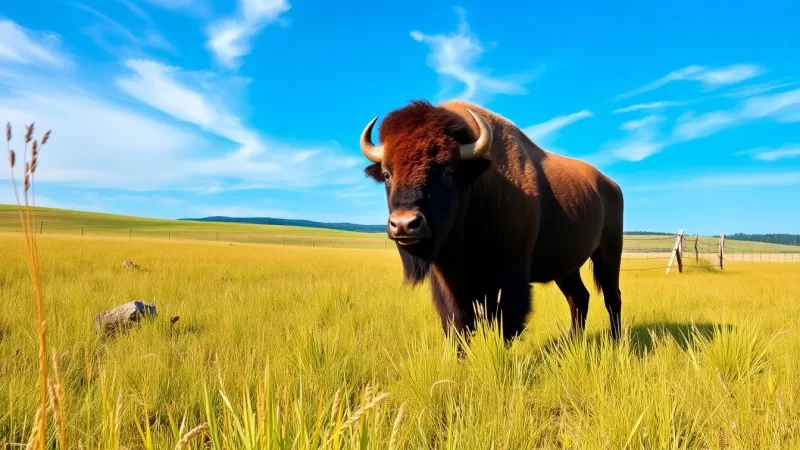The Extirpation of Bison (Bos bison) from Massachusetts: A Historical and Ecological Perspective

Introduction
Bison are among the most iconic animals in North America. They symbolize the wild spirit of the continent and played crucial roles in local ecosystems. These massive mammals once roamed across vast landscapes, including areas now part of Massachusetts. Understanding how Bison disappeared from Massachusetts helps us learn important lessons about conserving wildlife and restoring habitats. Today, Bison populations are growing in protected areas, thanks to dedicated conservation efforts. Still, their absence in Massachusetts remains a reminder of past mistakes and the need for ongoing environmental care.
Historical Presence of Bison in Massachusetts
Natural Range and Habitat in Pre-Colonial Times
Long before Europeans arrived, Bison stretched across the northeastern United States. Their range extended into parts of what is now Massachusetts. These animals thrived in open woodlands, grasslands, and prairies that provided food and water. Bison were an essential part of the landscape, shaping the land through grazing and movement. Indigenous tribes relied on Bison for food, clothing, and tools, making them central to local cultures and traditions.
Evidence of Bison in Colonial and Post-Colonial Era
History records and archaeological finds show that Bison once roamed Massachusetts. Native Americans hunted Bison in seasonal rounds, creating camps and villages nearby. When Europeans settled in the 1600s and 1700s, their arrival brought new threats. Land was cleared for farming, and Bison populations declined rapidly. Overhunting, combined with land loss, made it impossible for Bison to survive in the state. By the 1800s, they were gone from Massachusetts entirely.
Causes of Extirpation of Bison from Massachusetts
Overhunting and Market Demand
As trading and markets expanded, Bison meat became popular. People hunted them not just for survival but for profit. Hunters used rifles and trains to kill large numbers of Bison quickly. The demand for hides and meat led to reckless slaughter. State laws initially did little to control the hunting spree. Without protection, Bison populations in Massachusetts plummeted.
Habitat Loss and Land Use Changes
Native grasslands and open woodlands shrank as farmland expanded. Towns and cities grew, replacing Bison habitat with roads, buildings, and farms. Deforestation destroyed critical areas that Bison depended on. The land was transformed to suit human needs, leaving no space for these animals to roam. As a result, even surviving Bison could not find enough food or space.
Competition and Predation
European settlers brought domesticated livestock into Bison areas. Cattle and sheep competed for the same grasses Bison ate, making survival harder. Predators such as wolves and bears also affected Bison, especially when their numbers were already low. These pressures made it even more difficult for Bison to sustain their populations in Massachusetts.
Policy and Conservation Neglect
Early on, little attention was paid to Bison conservation. Governments allowed unregulated hunting and land exploitation. Without laws or protected areas, Bison populations continued to decline. The lack of early conservation efforts meant they vanished before anyone could save them.
Ecological and Cultural Impact of Bison Extirpation
Ecological Consequences
Bison helped keep grasslands healthy by grazing selectively and trampling plants. This activity created space for many other species to thrive. Their disappearance led to the decline of native plants and animals that depended on Bison-rich habitats. Without Bison, ecosystems lost a key component of their balance, resulting in less biodiversity and altered landscapes.
Cultural Significance and Indigenous Perspectives
For many Native American tribes, Bison are more than just animals. They are sacred and symbolize life and community. Their loss from Massachusetts disrupted cultural traditions and spiritual practices. Today, tribes continue to work for Bison restoration as part of cultural revival and environmental healing efforts. Protecting Bison means honoring history and preserving cultural identity.
Modern Restoration and Conservation Efforts
Reintroduction Programs in Other Regions
In places like Yellowstone, Bison have been reintroduced successfully. These efforts show that with careful planning, Bison can thrive in protected parks and reserves. Learning from these projects helps inform what it takes to restore Bison populations elsewhere.
Challenges of Reintroduction into Massachusetts
Restoring Bison to Massachusetts faces obstacles. There isn’t enough open, native habitat for a free-ranging herd. Farmland, roads, and urban areas block plans for large Bison parks. Regulatory hurdles and land ownership issues also make reintroduction difficult. Without suitable space, Bison cannot survive naturally in the region again.
Actions for Future Conservation
To bring Bison back, we need to protect and restore natural habitats. Creating corridors that connect protected areas can help Bison migrate and expand. Working closely with indigenous communities, farmers, and landowners is vital for success. Community programs that educate and involve local residents can also boost conservation efforts.
Conclusion
Bison once roamed Massachusetts, playing vital ecological and cultural roles. Overhunting, habitat destruction, and lack of early protection caused their extirpation. Restoring Bison could revive native ecosystems and reconnect communities with nature’s history. We must act now to protect what’s left and support habitat restoration. Learning from the past helps us prevent future loss of biodiversity. Protecting Bison is more than just saving an animal—it’s about preserving our shared heritage and the health of our lands.

